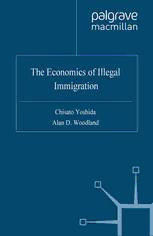
The Economics of Illegal Immigration PDF
Preview The Economics of Illegal Immigration
The Economics of Illegal Immigration The Economics of Illegal Immigration By Cllisato Yoshida ami Alan D.woodland * 0 Chisato Yoshida and Alan D. Woodland ZOOS Soft cover reprint of the hardcover 1st edition 2005 978-1-4039-2075-1 AU rights reserved. No reproduction, copy or transmission of this publication may be made without written permission. No paragraph of this publication may be reproduced. copied or transmitted save with written permission or in accordance with the provisions of the Copyright, Designs and Patents Act 1988, or under the terms of any licence permitting limited copying issued by the Copyright Licensing Agency, 90 Tottenham Court Road, London W1T 4LP. Arrj person who does any unauthorised act in relation to this publication may be liable to criminal prosecution and civil claims for damages. The authors have asserted their rights to be identified as the authors of this work in accordance with the Copyright, Designs and Patents Act 1988. First published ZOOS by PALGRAVE MACMILLAN Houndmills, Basingstoke, Hampshire RGZ1 6XS and 17S Fifth Avenue. New York. N.Y. 10010 Companies and representatives throughout the world PALGRAVE MACMILLAN is the global academic imprint of the Palgrave Macmillan division of St. Martin's Press, LLC and of Palgrave Macmillan Ltd. MacmiUanlll is a registered trademark in the United States, United Kingdom and other countries. Palgrave is a registered trademark in the Euro~n Union and other countries. ISBN 978-J-349-'i 1498-4 ISBN 978-0-230-51488-1 (eBook) DOI 10.1057/9780230514881 This book is printed on paper suitable for recycling and made from fuUy managed and sustained forest sources. A catalogue record for this book is available from the British Libral}l. Libral}l of Congress Cataloging-in-Publication Data Yoshida, Chisato. The economics of illegal immigration I by Chisato Yoshida and Alan D. Woodland. p.cm. Includes bibliographical references and index. 1. Emigration and immigration-Economic aspects. 2.11legal aliens Economic aspects. 3.Alien labor. I. Woodland, A. D. II. Title. JV6217.Y667 200S 331.6'Z 1724-dc22 2005045ZS7 s z 10 9 8 7 6 4 3 1 14 13 1Z 11 10 09 08 07 06 OS Contents Foreword ix ListofTables xiii ListofFigureandMaps xtv 1 Introduction I 1.1 Introduction 1 1.2 Illegal immigration;An overview 6 1.3 USimmigration laws& policies 14 1.4Immigration policy in EU 16 1.5Theeconomiceffectsofimmigration 18 1.6Theoreticalanalysesofillegalimmigration 20 1.7Outline 28 Part I TheWelfare Effects ofIllegal Immigration 2 TheGlobal Welfare EffectsofIllegal Immigration in theAbsenceofCapital Mobility 43 2.1 Introduction 43 2.2Thebasic model and main results 44 2.2.1Factor market equilibrium 44 2.2.2Welfareeffects 46 2.3 Concluding remarks 48 Mathematicalappendix 50 3 TheGlobal Welfare Effects ofIllegal Immigration In the Presence ofcapital Mobility 55 3.1Introduction 5S 3.2The basicmodeland main results S6 3.2.1 Factor market equilibrium S6 3.2.2Welfare effects 60 3.3Concludingremarks 62 Mathematical appendix 64 4 The Welfare Effeds ofBorder Patrol on Illegal Immigration 67 4.1Introduction 67 vi Content5 4.2 Thebasicmodel andmain results 68 4.2.1Factor market equilibrium 69 4.2.2 Welfareeffects 71 4.3 Capitalmobility 72 4.3.1 Factor market equilibrium 73 4.3.2Welfareeffects 74 4.4Concludingremarks 76 5 TheWelfare Effn:t.s offJnandng the Internal 7. Enforcement ofIllegal Immigration 5.1 Introduction 78 5.2 Thebasic model 79 5.2.1Factor market equilibrium 80 5.2.2Governmentbudget constraint 82 5.3 Welfare effects 83 5,4 Capital mobility 86 5,4.1Factor market equilibrium 86 5.4.2 Government budget constraint 88 5.5 Welfare effects 89 5.6 Concluding remarks 91 9. Part I: Final Conclusion Part II The Optimal Enforcement ofEmployer Sanctions 6 The Optimal Enforcement ofImmigration Law 97 6.1Introduction 97 6.2The basicmodel 98 6.3 The welfare analysisof internal enforcement 101 6.4 Internationalcapitalmobility 102 6.5Optimal enforcement 105 6.6Conclusion 107 7 The Optimal Enforcement of a Finance-Constrained Immigration Law 109 7.1 Introduction 109 7.2 Thebasic model 111 7.3Governmentbudgetconstraint 114 7.4 Awelfareanalysis ofinterior inspections 116 7.5 Internationalcapitalmobility 118 7.6Optimal enforcement 121 7.7 Conclusion 123 Contents vii Part II: Final Conclusion 125 Part III The Welfare Effects ofa Profit-Sharing Policy 8 Unemployment, International Migration and Profit-Sharing 129 8.1 Introduction 129 8.2 Thebasicmodel 130 8.2.1Thedomesticand foreign economies 131 8.2.2Welfareeffects 134 8.3 Capitalmobility 136 8.3.1Effectsofaprofit-sharingscheme 136 8.3.2Welfareeffects 138 8.4 Concluding remarks 139 Appendix 141 9 International Migration. Profit-Sharing andNational WeJfare 143 9.1Introduction 143 9.2The basicmodel 146 9.3Capitalmobility 155 9.4Concluding remarks 158 AppendiX 160 10 Cana Profit-SharingScheme Remedy Large Salle Unemployment in a Less DevelopedCountry? 163 10.1 Introduction 163 10.2Thebasicmodel 164 10.3Welfareeffect 169 10.4Concluding remarks 170 Afterword 172 Bibliography 177 Index 189 Foreword The recent globalization of national economies has led to a rapid in crease in the international mobility of goods, capital. information and labor.Weobservemanylabormovementsfrom lessdevelopedcountries, such as those in Southeast Asia and South-America, to developed coun tries, such asthose in Europe, North AmericaandJapan.These intema tional labor movementsare often motivated by the large wage differen tialsbetween these countries. This international labor mobility leads to serious problemsassociated with illegal employment of foreign migrants in labor-Importing coun tries, which are usually thedeveloped countries. Foreign migrants often work illegally as unskilled workers in the host country's finnsby legally entering the host country with a short-term sightseeing or training visa, and then illegallyover-staying theirtimein thehostcountry. In addition, there are many illegal foreign workers in developed countries who have illegally migrated to the host countryand work ille gally in the host country's firms. For example, there has been a recent increasein the number ofillegalMexican migrants to the United States (US).These illegal Mexican migrants are called "wet backs" in the US. Theirnamederivesfromthe anecdotethat theirbacksgetwetwhen they illegallymigratefromMexicoto theUSbyswimmingacrosstheriverRio Grande at theborderbetween thetwo countries(Borjas(1990». The governments of developed countries deal with the problem of illegal foreign workers mainly by using the following two enforcement tools:borderpatrolandinternal enforcement. Borderpatrol involvesthe prevention of attempted illegal migration at the border. Internal en forcementinvolvescatching foreignworkerswho areworking illegallyin domesticfirms,aprocesssometimescalledemployersanctions. Ethier (1986a) broke new ground by analyzing the effects of border and internal enforcement policies in a one-country model using a crime-theoretic analysis (Becker (1968». In his model, Ethier examined how a small country could use domestic border control and internal enforcement policies to achieve domestic policy objectives regarding illegalimmigrationand incomedistribution. Bond and Chen (1987) extended the Ethier model by constructing a standard, two-country,one-good,two-factor model.In their paper, they analyzed the effect of interior inspections by the host country's gov ernment on thehostcountry'swelfare.Theyshowed that impositionof ix
